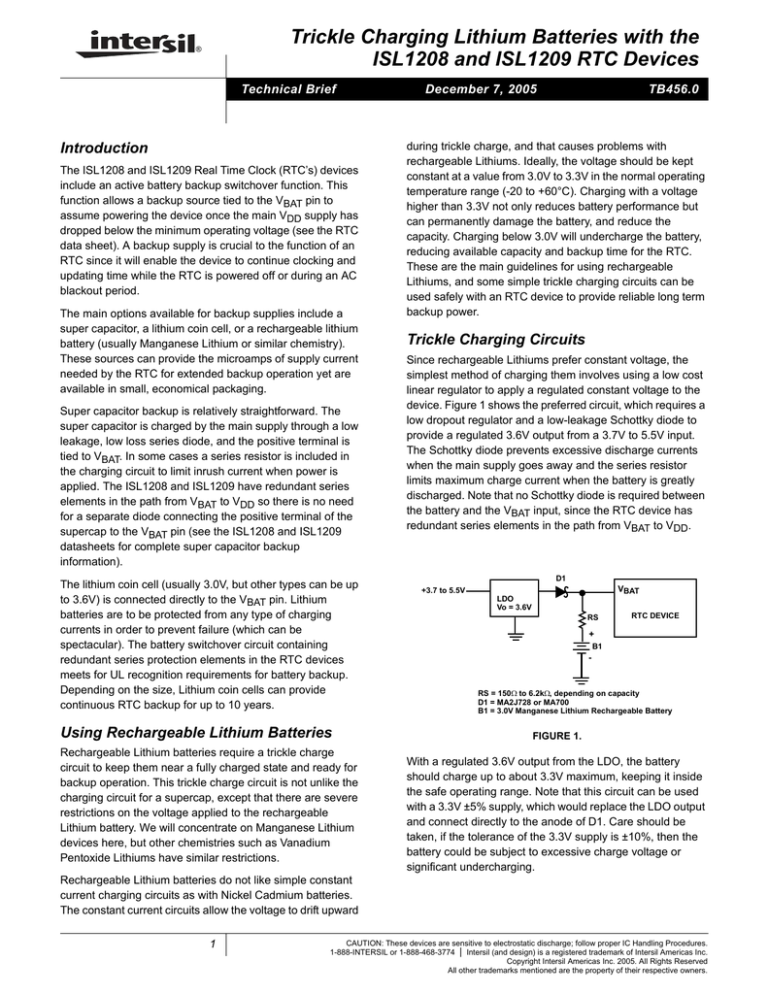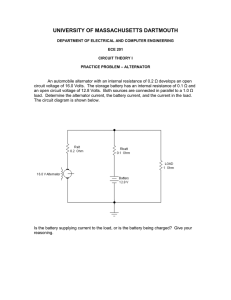
Trickle Charging Lithium Batteries with the
ISL1208 and ISL1209 RTC Devices
®
Technical Brief
Introduction
The ISL1208 and ISL1209 Real Time Clock (RTC’s) devices
include an active battery backup switchover function. This
function allows a backup source tied to the VBAT pin to
assume powering the device once the main VDD supply has
dropped below the minimum operating voltage (see the RTC
data sheet). A backup supply is crucial to the function of an
RTC since it will enable the device to continue clocking and
updating time while the RTC is powered off or during an AC
blackout period.
The main options available for backup supplies include a
super capacitor, a lithium coin cell, or a rechargeable lithium
battery (usually Manganese Lithium or similar chemistry).
These sources can provide the microamps of supply current
needed by the RTC for extended backup operation yet are
available in small, economical packaging.
Super capacitor backup is relatively straightforward. The
super capacitor is charged by the main supply through a low
leakage, low loss series diode, and the positive terminal is
tied to VBAT. In some cases a series resistor is included in
the charging circuit to limit inrush current when power is
applied. The ISL1208 and ISL1209 have redundant series
elements in the path from VBAT to VDD so there is no need
for a separate diode connecting the positive terminal of the
supercap to the VBAT pin (see the ISL1208 and ISL1209
datasheets for complete super capacitor backup
information).
The lithium coin cell (usually 3.0V, but other types can be up
to 3.6V) is connected directly to the VBAT pin. Lithium
batteries are to be protected from any type of charging
currents in order to prevent failure (which can be
spectacular). The battery switchover circuit containing
redundant series protection elements in the RTC devices
meets for UL recognition requirements for battery backup.
Depending on the size, Lithium coin cells can provide
continuous RTC backup for up to 10 years.
Using Rechargeable Lithium Batteries
Rechargeable Lithium batteries require a trickle charge
circuit to keep them near a fully charged state and ready for
backup operation. This trickle charge circuit is not unlike the
charging circuit for a supercap, except that there are severe
restrictions on the voltage applied to the rechargeable
Lithium battery. We will concentrate on Manganese Lithium
devices here, but other chemistries such as Vanadium
Pentoxide Lithiums have similar restrictions.
December 7, 2005
TB456.0
during trickle charge, and that causes problems with
rechargeable Lithiums. Ideally, the voltage should be kept
constant at a value from 3.0V to 3.3V in the normal operating
temperature range (-20 to +60°C). Charging with a voltage
higher than 3.3V not only reduces battery performance but
can permanently damage the battery, and reduce the
capacity. Charging below 3.0V will undercharge the battery,
reducing available capacity and backup time for the RTC.
These are the main guidelines for using rechargeable
Lithiums, and some simple trickle charging circuits can be
used safely with an RTC device to provide reliable long term
backup power.
Trickle Charging Circuits
Since rechargeable Lithiums prefer constant voltage, the
simplest method of charging them involves using a low cost
linear regulator to apply a regulated constant voltage to the
device. Figure 1 shows the preferred circuit, which requires a
low dropout regulator and a low-leakage Schottky diode to
provide a regulated 3.6V output from a 3.7V to 5.5V input.
The Schottky diode prevents excessive discharge currents
when the main supply goes away and the series resistor
limits maximum charge current when the battery is greatly
discharged. Note that no Schottky diode is required between
the battery and the VBAT input, since the RTC device has
redundant series elements in the path from VBAT to VDD.
D1
+3.7 to 5.5V
VBAT
LDO
Vo = 3.6V
RS
RTC DEVICE
+
B1
-
RS = 150Ω to 6.2kΩ, depending on capacity
D1 = MA2J728 or MA700
B1 = 3.0V Manganese Lithium Rechargeable Battery
FIGURE 1.
With a regulated 3.6V output from the LDO, the battery
should charge up to about 3.3V maximum, keeping it inside
the safe operating range. Note that this circuit can be used
with a 3.3V ±5% supply, which would replace the LDO output
and connect directly to the anode of D1. Care should be
taken, if the tolerance of the 3.3V supply is ±10%, then the
battery could be subject to excessive charge voltage or
significant undercharging.
Rechargeable Lithium batteries do not like simple constant
current charging circuits as with Nickel Cadmium batteries.
The constant current circuits allow the voltage to drift upward
1
CAUTION: These devices are sensitive to electrostatic discharge; follow proper IC Handling Procedures.
1-888-INTERSIL or 1-888-468-3774 | Intersil (and design) is a registered trademark of Intersil Americas Inc.
Copyright Intersil Americas Inc. 2005. All Rights Reserved
All other trademarks mentioned are the property of their respective owners.
Another more economical circuit uses a simple resistor
divider to provide a charging voltage to the battery, yet keep
it within the maximum guidelines allowable. Figure 2 shows
this circuit and components used.
VBAT
+5.0V ±5%
R1
D1
RTC DEVICE
+
B1
R2
-
R1 = 5.1kΩ
R2 = 9.1kΩ
B1 = 3.0V Manganese Lithium Rechargeable Battery
D1 = MA3X716
Note: R1 and R2 can be reduced in value to increase
charge current, but the ratio must stay the same.
FIGURE 2.
In this circuit the battery will draw current up to where the
resistor divider limits the voltage, thus providing a low trickle
charge near that voltage. In this circuit, the resistor divider is
set to slightly higher than 3.20V, and with the Schottky diode
drop this essentially limits the charge voltage to about 3.0V
max. Again, note that no Schottky diode is required between
the battery and the VBAT input, since the RTC device has
redundant series elements in the path from VBAT to VDD.
This circuit will allow the battery to charge very near 100%
capacity, but will take much longer time than the circuit in
Figure 1.
References
Panasonic; Charging circuits for ML Lithium Coin Cells;
http://www.panasonic.com/industrial/battery/oem/images/pdf
/Panasonic_Lithium_ML.pdf
Intersil Corporation reserves the right to make changes in circuit design, software and/or specifications at any time without notice. Accordingly, the reader is cautioned to
verify that the Application Note or Technical Brief is current before proceeding.
For information regarding Intersil Corporation and its products, see www.intersil.com
2
TB456.0
December 7, 2005




